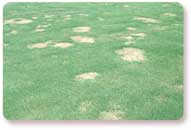
Spring Dead Spot
In late April and early May during the greening-up period for Bermuda lawns, you may notice large, circular or irregularly shaped dormant spots in your lawn. These "dead" spots are actually a disease, which is the result of a toxin produced by the fungus Leptoshaeria korrae. We call this disease Spring Dead Spot.
The onset of this disease usually occurs three to five years after the lawn is established, primarily in the northern regions of the Bermuda range (which includes Atlanta and North Georgia). Cold winters, excessive accumulation of thatch and lush, late-season growth can make this disease worse. However, these factors aren’t the cause, since the fungus creates a toxin that is unfavorable for Bermuda growth. As a result, the grass is slow to take over the affected areas.
Where complete control of this disease remains elusive, it is recommended that the following steps be taken to aid in recovery:
1. Raking the affected area and adding small amounts of topsoil.
2. Aeration of the lawn.
A more extreme measure is to remove the grass and soil 6" deep in the affected areas, and replacing with new topsoil and sprigs or pieces of Bermuda sod. Fungicides are not a reliable solution to control this disease and are not recommended.
Spring Dead Spot may be present in the lawn for several years, yet will often resolve itself. If you see this problem in your Bermuda lawn, please contact your King GREEN representative so that we may work with you to resolve it.






